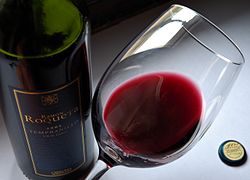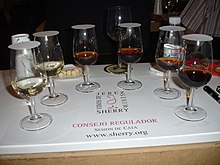tempanello
Tempranillo
Tempranillo
Grape (
Vitis)

Tempranillo in Viala & VermorelColor of berry skinNoirSpecies
Vitis viniferaAlso calledCencibel, Tinta Roriz (
more)Origin
SpainNotable regionsRioja, Spain
Ribera del Duero, Spain (
more)Notable wines
Vega SiciliaHazardsRot
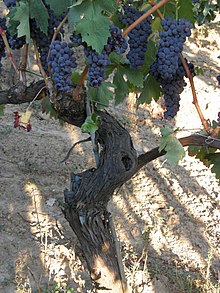

Ripening Tempranillo grapes
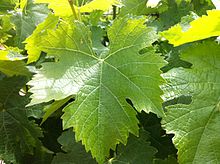

Tempranillo leaf.
Tempranillo is a variety of black
grape widely grown to make full-bodied red wines in its native Spain.
[1] Its name is the
diminutive of the
Spanish temprano ("early"),
[1] a reference to the fact that it ripens several weeks earlier than most Spanish red grapes. Tempranillo has been grown on the
Iberian Peninsula since the time of Phoenician
settlements. It is the main grape used in
Rioja, and is often referred to as Spain's
noble grape. Grown early in the 20th century to produce
jug wines in California, toward the end of the 20th century Tempranillo enjoyed a renaissance there and throughout the world as a fine wine. The grape has been planted in
Mexico,
New Zealand,
South America,
USA,
South Africa,
Australia,
Argentina,
Uruguay,
Turkey and
Canada.
Often blended with
Grenache and
Cariñena (known in Rioja as Mazuelo), Tempranillo is bottled either young or after several years of barrel aging. In Portugal, it is blended with others to produce
port wine. Often growing its best at higher altitudes, the grape yields wines that are ruby in colour, with
aromas and flavours of berries, plum, tobacco, vanilla, leather and herb.
For some time, Tempranillo was thought to be related to the
Pinot Noir grape. According to legend,
Cistercian monks left Pinot Noir cuttings at monasteries along their pilgrimage to
Santiago de Compostela. However,
ampelographic studies have shown no genetic connection between the cultivars.
[2][3]
Spanish cultivation of
Vitis vinifera, the common ancestor of almost all vines in existence today, began in earnest with
Phoenician settlement in the southern provinces. Later, according to the
Roman writer
Columella, wines were grown all over Spain; yet there are only scattered references to the name "Tempranillo".
Ribera del Duero wine making extends back over 2,000 years, as evidenced by the 66-metre mosaic of
Bacchus, the Roman god of wine, that was unearthed in 1972, at
Baños de Valdearados.
[4]
The grape was introduced to America, possibly as seeds, by the Spanish Conquistadors in the 17th century, where it has largely retained its genetic identity and still strongly resembles its Spanish ancestors.
[5] Despite its apparent fragility, Tempranillo travelled widely during the 20th century and, following much trial and error, has become established throughout the world. In 1905, Frederic Bioletti brought Tempranillo to
California where it received a cool reception not only due to the encroaching era of
Prohibition, but also because of the grape's dislike of hot, dry climates. It was much later, during the 1980s, that Californian Tempranillo wine production began to flourish, following the establishment of suitably mountainous sites. Production in this area has more than doubled since 1993.
[6]
During the 1990s, Tempranillo started experiencing a
renaissance in wine production worldwide. This surge began partly as a result of the efforts of a 'new wave' of Spanish growers who showed that it was possible to produce wines of great character and quality in areas outside of the Rojas region. One result of this has been that Tempranillo
varietal wines have become more common, especially in the better-suited, cooler Spanish regions like
Ribera del Duero,
Navarra, and
Penedès. During the 1990s, growers in
Australia and
South Africa started significant Tempranillo plantations.[
citation needed]
[edit] Viticulture
Tempranillo is a black grape with a thick skin.
[1] It grows best at relatively high altitudes, but it also can tolerate a much warmer climate.
[7] With regard to Tempranillo's production in various climates, wine expert
Oz Clarke notes,
To get elegance and acidity out of Tempranillo, you need a cool climate. But to get high sugar levels and the thick skins that give deep color you need heat. In Spain these two opposites are best reconciled in the
continental climate but high altitude of the Ribera del Duero.
[8]
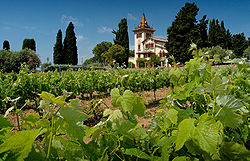

Tempranillo vines in Garraf province, Penedès region
In the Ribera del Duero the average July temperature is around 21.4°
Celsius (70.5°
Fahrenheit),
[9] though temperatures in the middle of the day in the lower valley can jump as high as 40 °C (104 °F). At night the region experiences a dramatic
diurnal temperature variation, with temperatures dropping by as much as 16 °C (30 °F) from the daytime high. The Tempranillo grape is one of the few grapes that can adapt and thrive in
continental Mediterranean climates like this.
[10]
Pests and diseases are a serious problem for this grape variety, since it has little resistance to either. The grape forms compact, cylindrical bunches of spherical, deep blue-black fruit with a colourless pulp. The leaves are large with five overlapping lobes.
[11]
The Tempranillo root absorbs
potassium easily, which facilitates pH levels of 3.6 in the pulp and 4.3 in the skin when it reaches maturity. If it absorbs too much potassium, the
must becomes salified (increased levels of salt), which slows the disappearance of
malic acid, resulting in a higher pH. The skin does not present any herbaceous characters. The grape is very susceptible to inclement weather, contracting when there is a drought and swelling when there is too much humidity. The swelling has a negative effect on quality since it affects the color of the wine. The effects of the weather are attenuated in places with
limestone because of the effect of the clay and humidity in the roots; the effects are worse in sandy areas, as well as for vines that are less than twelve years old, as the roots are generally too superficial.
[12][
better source needed]
[edit] Wines
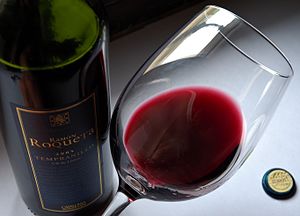

A Tempranillo varietal wine in a glass, showing typically intense purple colouring
Tempranillo wines are ruby red in colour, while
aromas and flavours can include berries, plum, tobacco, vanilla, leather and herb.
[13] Often making up as much as 90% of a blend, Tempranillo is less frequently bottled as a single varietal. Being low in both acidity and sugar content, it is most commonly blended with
Grenache (known as
Garnacha in Spain),
Carignan (known as
Mazuela in Spain),
Graciano,
Merlot and
Cabernet Sauvignon. Blending the grape with Carignan makes a brighter and more acidic wine.
[1] Tempranillo is the major component of the typical Rioja blends and constitutes 90-100% of Ribera del Duero wines.
[1] In Australia, Tempranillo is blended with Grenache and
Syrah. In Portugal, where it is known as
Tinta Roriz, it is a major grape in the production of some
Port wines.
[14]
[edit] Regions
[edit] Spain
Tempranillo is native to northern Spain and widely cultivated as far south as
La Mancha. The two major regions that grow Tempranillo are Rioja, in north central Spain, and Ribera del Duero, which lies a little farther to the south. Substantial quantities are also grown in the Penedès, Navarra and Valdepeñas regions.
[13]
Tempranillo is known under a number of local synonyms in different regions of Spain: Cencibel and Tinto Fino are used in several regions, and it is known as Tinta del País in
Ribera del Duero and the surrounding area, Tinta de Toro in
Toro, Ull de llebre in
Catalonia and Morisca in
Extremadura.
[edit] Portugal
The grape plays a role in the production of wines in two regions of
Portugal,
central Alentejo and
Douro. In Alentejo Central it is known as Aragonez and used in red table wine blends of variable quality, while in the Douro it is known as Tinta Roriz and mainly used in blends to make
port wine.
[14]
[edit] New World production


The original 1993 planting of Tempranillo at Red Willow Vineyard in Washington state.
Tempranillo arrived in California bearing the name Valdepeñas, and it was grown in the Central Valley at the turn of the 20th century. Since the climate of the Central Valley was not ideal for the grape, it was used as a blending grape for
jug wine.
[1] California has since started to use it for fine wines. In Texas, the soils of the High Plains and Hill Country have been compared to those of northern Spain. Tempranillo has been well received in Texas and has grown to be considered the state's signature grape.
[15][16]
In
Oregon State, the grape was introduced by Earl Jones of
Abacela Vineyards and Winery, in the
Umpqua Valley.
[1] In Southern Oregon, near Medford, the Applegate Valley wine appellation is now growing some good Tempranillo grapes (
http://applegatewinetrail.com/). The
Valley View Vineyardwas established there back in the 1972 and their Tempranillo is now available on Amazon.com. Their climate (hot during the summer day, and cool overnight) seems to be perfect for the Tempranillo grape. In
Australia Tempranillo is grown in the
McLaren Vale region.
[17] Tempranillo has also been introduced by some wine producers in Thailand.
[18] The varietal is extensively grown in
Argentina,
Chile, and
Mexico.
In
Washington state, Tempranillo was one of the varieties pioneered in the state by
Red Willow Vineyard in the
Yakima Valley AVA with its first commercial planting of the variety in 1993.
[19]
[edit] Synonyms
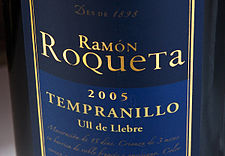

Label showing both Tempranillo and the synonym used in
Catalonia, Ull de Llebre.
Tempranillo is known by other names in certain regions. These include:
Albillo *****, Aldepenas, Aragon, Aragones, Aragonez, Aragonez 51, Aragonez da Ferra, Aragonez de Elvas, Arganda, Arinto Tinto, Cencibel, Cencibera, Chinchillana, Chinchillano, Chinchilyano, Cupani, De Por Aca, Escobera, Garnacho Fono, Grenache de Logrono, Jacibera, Jacibiera, Jacivera, Juan Garcia, Negra de Mesa, Negretto, Ojo de Liebre, Olho de Lebre, Pinuela, Sensibel, Tempranilla, Tempranillo de la Rioja, Tempranillo de Perralta, Tempranillo de Rioja, Tempranillo de Rioza, Tempranillo Rioja, Tinta Aragones, Tinta Corriente, Tinta de Madrid, Tinta de Santiago, Tinta de Toro, Tinta do Inacio, Tinta do Pais, Tinta Fina, Tinta Madrid, Tinta Monteira, Tinta Monteiro, Tinta Roris, Tinta Roriz, Tinta Santiago, Tinto Aragon, Tinto Aragonez, Tinto de la Ribera, Tinto de Madrid, Tinto de Rioja, Tinto de Toro, Tinto del Pais, Tinto del Toro, Tinto Fino, Tinto Madrid, Tinto Pais, Tinto Ribiera, Tinto Riojano, Ull de Liebre, Ull de Llebre, Valdepenas, Verdiell, Vid de
Tempranillo is ,The King of Spanish wines,Its varies in Usage, As does The
Cabernet,Or the
SANGIOVESE It is part of the backbone
Of the Spanish wine industry, Regardless of the name it's given, It is still tampanella.Have any of you out there,ever made a TEMPRANILLO,It can be a very finicky Wine, to work with I did some three years in a row From Chilean juice,Even though this is basically an every day table wine, It really does has nice characteristics,I am not sure if this comes in the kit form or not But if it does , do a kit Then by all means try this . It is quite distinctive and different Very Similar to A SANGIOVESE As stated before But I think with the kit The more concentrated You will have more definition in the finished product,if you have chance To buy an inexpensive bottle, Then by all means do so, Expander your palette– You might be surprised.

 Welcome back, they waiting for you
Welcome back, they waiting for you let's first do a little history lesson after all you don't know where the winds heritages comes from knowing you've missed a large part of the winemaking effort.
let's first do a little history lesson after all you don't know where the winds heritages comes from knowing you've missed a large part of the winemaking effort. German wine is primarily produced in the West of Germany, along the river Rhine and its tributaries, with the oldest plantations going back to the Roman era. Proximally 60% of the German wine production is situated in the federal state of Rhineland-palatinate, where six of the 13 regions for quality one is situated. Germany has about 102,000 hectares were about 252,000 acres of vineyard, which is room 1/10 of the vineyard surface in Spain, France or Italy. The total volume production is usually around 9 million hectoliters annually, corresponding to 21.2 billion bottles, which places Germany as the eighth largest wine producing country in the world white wine accounts for most two thirds of the total production.
German wine is primarily produced in the West of Germany, along the river Rhine and its tributaries, with the oldest plantations going back to the Roman era. Proximally 60% of the German wine production is situated in the federal state of Rhineland-palatinate, where six of the 13 regions for quality one is situated. Germany has about 102,000 hectares were about 252,000 acres of vineyard, which is room 1/10 of the vineyard surface in Spain, France or Italy. The total volume production is usually around 9 million hectoliters annually, corresponding to 21.2 billion bottles, which places Germany as the eighth largest wine producing country in the world white wine accounts for most two thirds of the total production. As a wine country, and Germany has a mixed reputation internationally, with some consumers or want to export markets associating Germany with the world's most elegant and aromatic or white wines while others see the country namely as a source of cheap, mass market semisweet wines such as liebfraumilch. Among enthusiasts, Germany's reputation is primarily based on wines made from the Riesling grape variety, which at its best is used for aromatics, fruity and elegant white wines that range from very crisp and dry two well balanced swing an enormous aromatic concentrations. These are my style wines I love a nice clean Riesling or piesporter great any time this is the one you should always have one and in your inventory, but getting carried away.
As a wine country, and Germany has a mixed reputation internationally, with some consumers or want to export markets associating Germany with the world's most elegant and aromatic or white wines while others see the country namely as a source of cheap, mass market semisweet wines such as liebfraumilch. Among enthusiasts, Germany's reputation is primarily based on wines made from the Riesling grape variety, which at its best is used for aromatics, fruity and elegant white wines that range from very crisp and dry two well balanced swing an enormous aromatic concentrations. These are my style wines I love a nice clean Riesling or piesporter great any time this is the one you should always have one and in your inventory, but getting carried away. While primarily a white wine country, rep production surged in the 1900s and early 2000's primarily fueled by domestic demand, and the proportions of German vineyards devoted to this cultivation of dark – skin drapes righties has now stabilized at slightly more than a third of the total surface, another words they got into a little bit of red wine, for the red wines Pinot Noir is in the lead. Now who doesn't like a Pinot Noir
While primarily a white wine country, rep production surged in the 1900s and early 2000's primarily fueled by domestic demand, and the proportions of German vineyards devoted to this cultivation of dark – skin drapes righties has now stabilized at slightly more than a third of the total surface, another words they got into a little bit of red wine, for the red wines Pinot Noir is in the lead. Now who doesn't like a Pinot Noir
 German wine is primarily produced in the West of Germany, along the river Rhine and its tributaries, with the oldest plantations going back to the Roman era. Proximally 60% of the German wine production is situated in the federal state of Rhineland-palatinate, where six of the 13 regions for quality one is situated. Germany has about 102,000 hectares were about 252,000 acres of vineyard, which is room 1/10 of the vineyard surface in Spain, France or Italy. The total volume production is usually around 9 million hectoliters annually, corresponding to 21.2 billion bottles, which places Germany as the eighth largest wine producing country in the world white wine accounts for most two thirds of the total production.
German wine is primarily produced in the West of Germany, along the river Rhine and its tributaries, with the oldest plantations going back to the Roman era. Proximally 60% of the German wine production is situated in the federal state of Rhineland-palatinate, where six of the 13 regions for quality one is situated. Germany has about 102,000 hectares were about 252,000 acres of vineyard, which is room 1/10 of the vineyard surface in Spain, France or Italy. The total volume production is usually around 9 million hectoliters annually, corresponding to 21.2 billion bottles, which places Germany as the eighth largest wine producing country in the world white wine accounts for most two thirds of the total production. As a wine country, and Germany has a mixed reputation internationally, with some consumers or want to export markets associating Germany with the world's most elegant and aromatic or white wines while others see the country namely as a source of cheap, mass market semisweet wines such as liebfraumilch. Among enthusiasts, Germany's reputation is primarily based on wines made from the Riesling grape variety, which at its best is used for aromatics, fruity and elegant white wines that range from very crisp and dry two well balanced swing an enormous aromatic concentrations. These are my style wines I love a nice clean Riesling or piesporter great any time this is the one you should always have one and in your inventory, but getting carried away.
As a wine country, and Germany has a mixed reputation internationally, with some consumers or want to export markets associating Germany with the world's most elegant and aromatic or white wines while others see the country namely as a source of cheap, mass market semisweet wines such as liebfraumilch. Among enthusiasts, Germany's reputation is primarily based on wines made from the Riesling grape variety, which at its best is used for aromatics, fruity and elegant white wines that range from very crisp and dry two well balanced swing an enormous aromatic concentrations. These are my style wines I love a nice clean Riesling or piesporter great any time this is the one you should always have one and in your inventory, but getting carried away. While primarily a white wine country, rep production surged in the 1900s and early 2000's primarily fueled by domestic demand, and the proportions of German vineyards devoted to this cultivation of dark – skin drapes righties has now stabilized at slightly more than a third of the total surface, another words they got into a little bit of red wine, for the red wines Pinot Noir is in the lead. Now who doesn't like a Pinot Noir
While primarily a white wine country, rep production surged in the 1900s and early 2000's primarily fueled by domestic demand, and the proportions of German vineyards devoted to this cultivation of dark – skin drapes righties has now stabilized at slightly more than a third of the total surface, another words they got into a little bit of red wine, for the red wines Pinot Noir is in the lead. Now who doesn't like a Pinot Noir























































